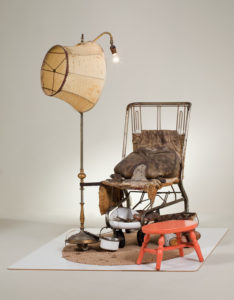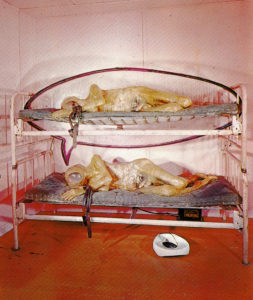
“The Illegal Operation”
Walking into the Kienholz retrospective at the Whitney Museum is like wandering onto the set of Alfred Hitchcock’s “Psycho.” There’s an overwhelming sense of decay, of morbidity, and the feeling that, any minute, something terrible is going to happen.
No knives descend, but visitors come face-to-face with an atrophied old woman in a chair who is easily as frightening as Anthony Perkins’ long-deceased mother. It is the first of many jolts in an exhibit that has the atmosphere of a freak show and a taxidermist’s shop.
Edward Kienholz, who died in 1994, probably wouldn’t quarrel with that description. An iconoclast with a ghoulish sensibility, he loved to shock and to outrage. He made a big splash in the Sixties with a piece called “Back Seat Dodge ’38,” in which a pair of mannequins grope each other in the rear of a truncated car.
A member of the beat generation and a self-taught artist, the Washington State-born Kienholz worked his way up through abstract styles and settled into a career of making assemblages and total environments out of the detritus of flea markets and secondhand stores.
It’s mostly that moldiness that defines his sensibility, and makes him interesting. It’s probably fair to say that he strove to instill a sense of disgust with the same zeal that previous generations had tried to capture beauty.
Although he never really gained the fame of contemporaries like Robert Rauschenberg or Jasper Johns – his passions were alien to the cool ironies of pop – his work has gained a certain posthumous stature, perhaps because of his savage political and social criticism, not to mention a current taste for the grotesque. His confrontations with war, racism, and sexuality made him something of a artistic misfit during the Sixties, Seventies, and Eighties, but now, of course, political art is all the rage, and Kienholz looks like a prophet.
The two floors of the show correspond to the two phases of his career, the works he did independently before 1972, and those he did in collaboration with his wife, Nancy Reddin Kienholz.
Ironically, the political stuff – which probably got him in the door of Whitney – is what seems the most trite and dated now. Our eyes tend to gloss over in front of “The Portable War Memorial,” created in 1968, at the height of the Vietnam War. Back then, it might have seemed cutting edge, the way it brashly juxtaposed consumer culture with the war machine: the familiar image of soldiers on Iwo Jima erecting the American flag within the setting of an American diner. But in today’s more ambiguous political environment, as the United States wrestles with intractable problems like Bosnia and the Middle East, this pat Sixties rhetoric seems about as profound as “Make Love, Not War.”
Although there’s a lot of sex in the show, it’s difficult to get a sense of Kienholz’s attitude, since he renders it, like everything, as something vulgar and repulsive. Or is it society’s attitude that’s vulgar? Or is he using sexual imagery as a metaphor for moral or political corruption? It’s not always easy to tell.
“Roxy’s” (1961-62), Kienholz’s first complete environment, was inspired by memories of a small-town Nevada brothel. The room itself has a sentimental feeling, a loving re-creation, with its dreary furnishings, threadbare Oriental carpets, wallpaper, and Maxfield Parrish prints of Greek temples in romantic moonlight. In contrast, the occupants – the prostitutes – belong to a chamber of horrors. Five Dollar Billy, for example, has a rose growing from her neck and a squirrel crawling out of her breast, and is spread out like a sacrificial animal on a treadle sewing machine.
Kienholz’s best works are the less baroque, less elaborate installations, where the emotional impact is more focused. “The Illegal Operation” presents a room in which a botched abortion has occurred. There’s a bedpan filled with dirty instruments, a bucket filled with soiled rags, and an operating table made from a shopping cart. The patient is represented by a sack in which hardened concrete oozes from the torn bottom.

“State Hospital”
Also successful is “State Hospital,” which draws on Kienholz’s experience as an attendant in a mental hospital. The work consists of a naked male figure on the bed. In place of his face is a goldfish bowl in which two black fish are swimming. Above this figure is a second figure, with a neon thought balloon around it that makes it appear that the first figure is imagining the second; he is in such a depressive state that he can literally think of nothing except the horrendous reality of the present moment.
In “Art Show” Kienholz carries off a bit of social satire, spoofing the art world and the denizens of galleries. It reproduces an opening, with a complete cast of art world characters drinking, smoking, talking, watching one another, and scrutinizing the works. But in place of their mouths, they have metal vents, like those from hair driers; when the visitor presses a button these blow hot air and a tape recorder plays a litany of pretentious art world talk.
He made the piece when he himself was enjoying some gallery success, which just proves that Kienholz, the ultimate iconoclast, had no sacred cows.

